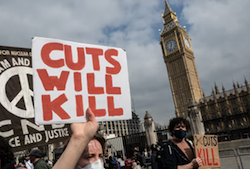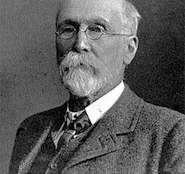The veil debate obscures a bigger question, says BEN TURLEY. What place should faith have in our public life?
When, on 5 October 2006 in the Lancashire Times, Jack Straw started a debate about the wearing of the veil by Muslim women, he did so with characteristic modesty and equivocation. While Straw said that that the wearing of the veil makes ‘better, positive relations between … communities more difficult’, he acknowledged that the Muslim woman he first asked to remove her veil was otherwise well-integrated. In fact she had chosen to wear the veil out of personal religious conviction and her desire to escape the male gaze.
Straw admitted at the end of the article that his concerns could be misplaced. But‚ he added, ‘I think there is an issue here’. How right he was!
Immediately following his comments, there was a media feeding frenzy. Politicians, including the prime minister and Straw himself, firmed up the questions‚ raised in Straw’s initial article into full-blown criticism of the veil. The PM called the wearing of the veil ‘a mark of separation’ which raised a more general question: ‘how we make sure the Muslim community integrates’.
Naturally, these words did not help to dampen down the situation and two months after Straw’s original article the regional press is still carrying stories of acts of discrimination against veil-wearing women, ranging from assault to refusal of service. One cannot help suspect that the issue has been whipped up by the media in a way that has been damaging to the public interest. Instead of the debate which Straw had invited, opinion has been polarised in a particularly unhelpful way.
However, the press alone are not to blame. Tony Blair’s words were not well-chosen. In an article in the Sunday Times on 22 October, Trevor Philips, chair of the Commission for Racial Equality and chair designate of the new Commission for Equality and Human Rights, noted that positions on the veil were already becoming entrenched and feared a deterioration in race relations as a result.
He defended Straw, however, saying ‘it was entirely reasonable for him to express his discomfort’, and noted that ‘barriers to honesty and understanding are a disaster for race relations‘. Philips went on to say that ‘the real crisis is our failure to adjust to change … and our failure to find a civilised way of talking about our diversity’. In his view, Straw‘s comment was as much ‘about him and his generation as it was about the niqab’.
Discrimination
At the same time, it was unfortunate (for everyone except journalists and lawyers) that a Muslim bilingual classroom support worker from Dewsbury, West Yorkshire, Aishah Azmi, was suspended for wearing a veil in class. Her case was taken under new legislation to prevent religious discrimination and, although she succeeded with her claim of victimisation (thereby winning a whopping injury to feelings award of £1,100), she failed to establish that her suspension constituted either direct or indirect discrimination.
This may seem strange to an outsider to discrimination law, but in fact it was quite predictable. The employment tribunal accepted that the correct comparator in a claim for direct discrimination of this kind was with a non-Muslim woman who covered her face. Otherwise, any attempt by employers to control religious dress would be doomed, because once direct discrimination has been established there is no defence an employer can use. Her claim of direct discrimination duly failed.
Subsequently, it was successfully argued that the requirement not to wear a niqab was a ‘provision, criteria or practice’, so Azmi could claim she had suffered indirect discrimination. However, under the law, this form of discrimination is justified if the employer can show that the ‘provision, criteria or practice’ is a proportionate means of achieving a legitimate end. In this case, of course, it was.
Although taken under discrimination law and not the Human Rights Act, the case recalls that of the Muslim schoolgirl and Denbigh High School. Eventually, the House of Lords found that the school, which had consulted widely with the local Muslim community and Islamic authorities, was within its rights to exclude the girl for refusing to comply with school uniform by covering herself from head to toe.
However, in its progress to the House of Lords, the case ‘uncovered’ some interesting faultlines in the UK constitution. The Court of Appeal, for instance, noted that the issue would never have arisen in Turkey, which has a secular constitution and bans the wearing of headscarves for religious purposes in all state educational institutions. The position in England is unclear. It is because our head of state, the Queen, is also the head of the Church that the issue of religious freedom was engaged in the first place. After all, religious organisations control many schools and it is government policy to encourage this.
On the other hand, events in France suggest that a secular constitution is not a simple answer to this particular problem. In fact, the riots there last year gave credence to Christian voices who argue that Muslims will only be successfully engaged by other people of faith. Unfortunately, the Pope’s attempt to say this led to uproar when, for reasons known only to himself, he prefaced his remarks by quoting a Byzantine emperor’s less-than flattering assessment of Islam.
The Archbishop of Canterbury, Dr Rowan Williams, however, has proved to be less gaffe-prone. In 2005, in a prayer meeting in Lyons, he called for a secular state in the UK which acknowledged the role of religion in civic and personal life as a way of addressing the UK’s multi-faith (and no faith) society.
Suspicion
The idea of a no-faith society brings us to another issue. Generally, people in Britain are suspicious of those with overt religious faith, particularly when that faith seems to encourage support for theocracy. This suspicion may be rooted in England’s protestantism, which still has some cultural influence despite the waning spiritual authority of Christian teachings. After all, our whole modern history (in constitutional terms at least) is arguably shaped by anti-Catholicism.
This is not to say that there is no rational basis to criticise the wearing of veils. In the schoolgirl case mentioned above, the Court of Appeal noted, without questioning, hearsay evidence from the school that it had been approached by Muslim parents and children who were concerned about the political views of the Begum family who wanted to establish Ms Begum’s right to wear the veil despite school uniform policy. It was alleged that there was a feeling they wanted to divide the community into good Muslims and bad Muslims, and show that good Muslims were the most politicised and fundamentalist.
Furthermore, Salman Rushdie may be right, the veil may ‘suck’, largely because of the way it separates women from the civic sphere with the excuse that it protects them from intrusive male attention. What about men doing something about their behaviour?
Whatever the merits of wearing veils, the question is not simply about ‘them’ fitting in with ‘our ways’ (whatever ‘our ways’ might be). It is surely about a dialogue concerning the relationship between faith and the state, faith and politics, and faith in society, as well as, crucially, women and religion. In fact, it is not common for Muslim women to wear veils, and to turn it into a symbol of Islam has only played into the hands of people who want to define Islam as a theocratic religion that seeks political and cultural hegemony.
Straw was right to ask the question about veils, the problem has been our response.


